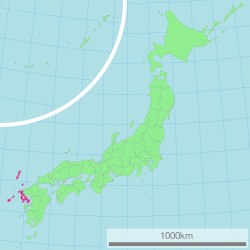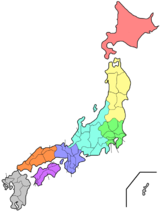Nagasaki Prefecture
|
||||||||||||||||||||||||||||||||||||||||||||||||||||||
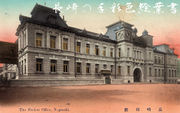
Nagasaki Prefect Office, Meiji Period
|
||||||||||||||||||||||||||||||||||||||||||||||||||||||
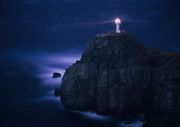
Lighthouse at Osezaki in Gotō
|
||||||||||||||||||||||||||||||||||||||||||||||||||||||
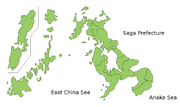
Map of Nagasaki Prefecture
|
||||||||||||||||||||||||||||||||||||||||||||||||||||||
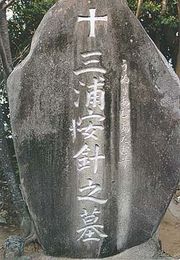
Grave of William Adams in Hirado
|
||||||||||||||||||||||||||||||||||||||||||||||||||||||

Castle in Shimabara
|
||||||||||||||||||||||||||||||||||||||||||||||||||||||

Sōfuku-ji Ōbaku Zen temple in Nagasaki
|
||||||||||||||||||||||||||||||||||||||||||||||||||||||
Nagasaki Prefecture (長崎県 Nagasaki-ken) is a prefecture of Japan located on the island of Kyūshū. The capital is the city of Nagasaki.
Contents |
History
Nagasaki Prefecture, a unification of the western half of the former province of Hizen, with the former island provinces of Tsushima and Iki, has had close ties with foreign civilization for centuries. Facing China and Korea, the region around Hirado was a traditional center for both traders and pirates.
During the 16th century, Catholic missionaries and traders from Portugal arrived and became active in Hirado and Nagasaki, which became a major center for foreign trade. After being given free rein in Oda Nobunaga's period, the missionaries were forced out little by little, until finally, in the Tokugawa era, Christianity was banned under the Sakoku national isolation policy, during which time, Japanese foreign trade was restricted to Chinese and Dutch traders based at Dejima in Nagasaki; however, Kirishitan (Japanese Christian) worship continued underground. These Kakure Kirishitan (hidden Christians) were tried at every step, forced to step on fumi-e ("trample pictures", images of the Virgin Mary and saints) to prove that they were non-Christian. With the banishment of all Catholic missionaries, traders from Catholic countries were also forced out of the country. Along with them, their children, half Japanese and half European, were also forced to leave the country. The majority was sent to Jagatara (Jakarta) and are still remembered by the locals as the people who wrote the poignant letters which were smuggled across the sea to their homeland. Today, Nagasaki has a prominent Chinatown[1] and Catholic churches.
During the Meiji Restoration, Nagasaki and Sasebo became major ports for foreign trade, and eventually major military bases and shipbuilding centers for the Imperial Japanese Navy up to World War II. On August 9, 1945, the United States dropped an atomic bomb on Nagasaki, which completely destroyed all buildings in a one mile radius from the point of impact and extensively damaged other parts of the city. 70,000 people died and over 70,000 more were injured in the attack.
Geography
Nagasaki borders Saga Prefecture on the east, and is otherwise surrounded by water, including Ariake Bay, the Tsushima Straits, and the East China Sea. It also includes a large number of islands such as Tsushima and Iki. Most of the prefecture is near the coast and there are a number of ports such as Nagasaki and a United States Navy base at Sasebo.
Regions
Nagasaki Prefecture currently has 13 cities, 4 districts, and 8 towns. There are currently no municipalities with the designation of village within Nagasaki Prefecture.
Cities
- Gotō
- Hirado
- Iki
- Isahaya
- Matsuura
- Minamishimabara
- Nagasaki (capital)
- Ōmura
- Saikai
- Sasebo
- Shimabara
- Tsushima
- Unzen
Districts
- Higashisonogi District
- Hasami
- Higashisonogi
- Kawatana
- Kitamatsuura District
- Ojika
- Saza
- Minamimatsuura District
- Shinkamigotō
- Nishisonogi District
- Nagayo
- Togitsu
Mergers and dissolutions
The following municipalities have been dissolved during the last seven years.
- Kitamatsuura District:
- Emukae, Fukushima, Ikitsuki, Kosaza, Ōshima, Sechibaru, Shikamachi, Tabira, Takashima, Uku, Yoshii
- Minamimatsuura District:
- Arikawa, Kamigotō, Kishiku, Miiraku, Narao, Naru, Shin'uonome, Tamanoura, Tomie, Wakamatsu
- Nishisonogi District:
- Iōjima, Kinkai, Kōyagi, Nomozaki, Ōseto, Ōshima, Saikai, Sakito, Sanwa, Seihi, Sotome, Takashima, Tarami
- Kitatakaki District:
- Iimori, Konagai, Moriyama, Takaki
- Minamitakaki District:
- Aino, Ariake, Arie, Azuma, Chidiwa, Fukae, Futsu, Kazusa, Kitaarima, Kuchinotsu, Kunimi, Minamiarima, Minamikushiyama, Mizuho, Nishiarie, Obama
- Kamiagata District:
- Kamiagata, Kamitsushima, Mine
- Shimoagata District:
- Izuhara, Mitsushima, Toyotama
- Iki District:
- Ashibe, Gonoura, Ishida, Katsumoto
Economy
Culture
Religion
Nagasaki is the most Christianized area in Japan with Roman Catholic missions having been established there as early as the 16th century. See Shusaku Endo's novel "Silence" which draws from the oral history of the local Christian ( Kirishitan ) communities, both Kakure Kirishitan and Hanare Kirishitan.
As of 2002, there are 68,617 Catholics in Nagasaki Prefecture, accounting for 4.52 percent of the total population of the prefecture.
Sports
The Nagasaki Saints of the Shikoku-Kyūshū Island League make Nagasaki Prefecture their home.
Tourism
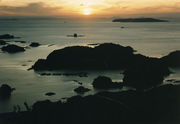
- Nagasaki (capital city)
- Ōura Cathedral (大浦天主堂)
- Urakami Cathedral (浦上天主堂)
- Confucius Shrine
- Glover Garden (グラバー園)
- Nagasaki Shinchi Chinatown
- Mount Inasa
- Kōfuku-ji
- Sōfuku-ji
- Suwa Shrine
- Hirado
- Hirado Castle
- Sakikata Park
- Sasebo
- Kujū-ku Islands
- Huis Ten Bosch (theme park)
- Saikai
- Nagasaki Bio Park
- Shimabara Peninsula
- Mount Unzen
- Shimabara Castle
References
External links
|
||||||||||||||||||||||
|
|||||||||||||||||||||||||||||||||
